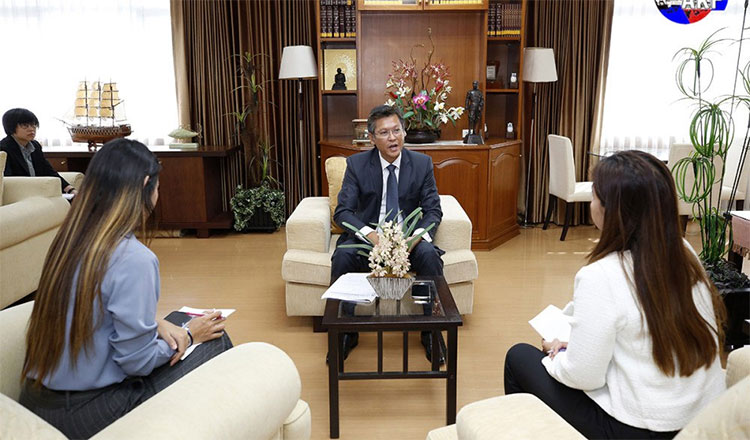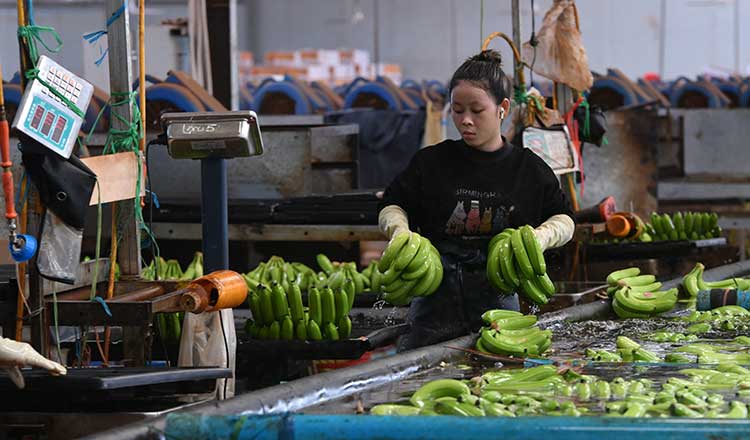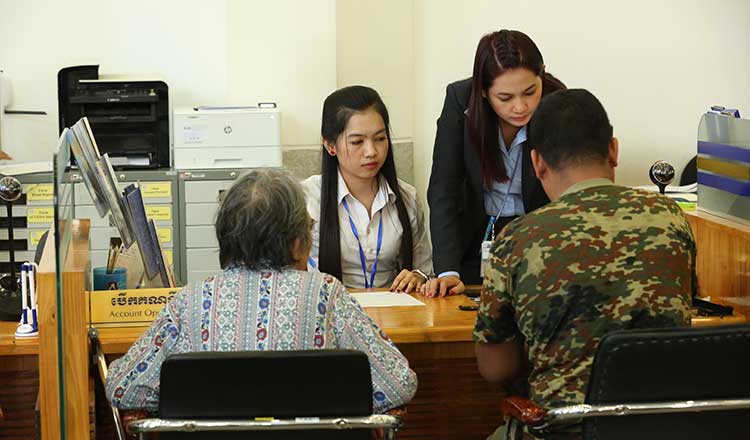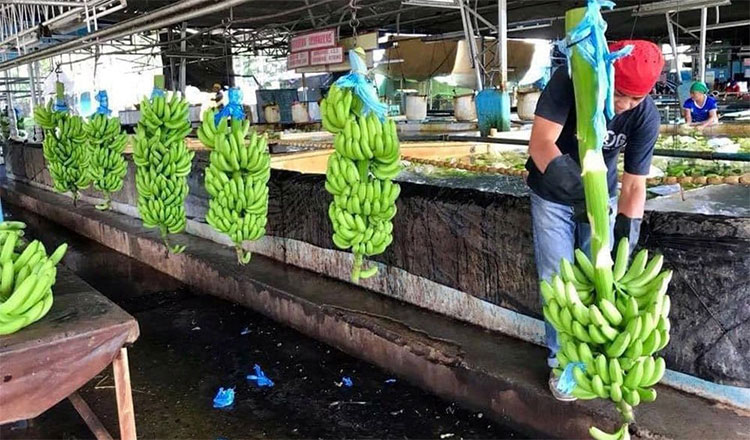Cambodia’s 1 million tonne rice export target within reach
Cambodia’s 1 million tonne rice export target within reach
The Kingdom’s rice export target of 1 million tonne by 2025 appears viable. While the achievement will bolster the confidence of current production systems down the line, it will also become a potent factor in Cambodia attaining a high-middle-income country status by 2030 and a high-income one by 2050. The growing clout of Cambodian rice across the continents will no doubt help the rice sector to scale new heights, but not before addressing the fundamental challenges such as strengthening the quality of rice, safety and aesthetics of the packaging

One of the cardinal reasons behind the Royal Government of Cambodia’s (RGC) confidence to transform the Kingdom into a high-middle-income country by 2030 and a high-income country by 2050 stems essentially from the government’s ambition to boost rice exports to 1 million tonne by 2025.
Estimates of rice exports including informal exports suggest that rice is by far the most important agricultural export product of Cambodia. Although exports include paddy rice, milled rice is increasingly considered to have important potential for future exports.
In May this year, Minister of Commerce Cham Nimul went on record saying during the ‘Formulation Process of Cambodia’s Milled Rice Market Expansion and Diversification Strategy’, that Cambodia is seeking new markets for its rice, mainly tapping countries that have free trade agreements with the Kingdom.
“The Ministry of Commerce (MoC) is working to promote and open up markets for our milled rice through the Cambodia-China Free Trade Agreement, the Cambodia-Korea Free Trade Agreement, the Regional Comprehensive Economic Partnership Agreement, and the Cambodia-United, Arab Emirates Comprehensive Economic Partnership Agreement,” she said at the ministry’s annual conference.
1 million tonne mission
How will Cambodia achieve its 1 million rice export target? Some of the measures that the government and stakeholders want to incorporate are improving the quality of packaging, marketing, expanding the network and lowering the cost of production such as fertilizers, gasoline and transportation.
Chan Sokheang, President of the Cambodian Rice Federation (CRF), is optimistic about achieving the target by 2025. Speaking to Khmer Times, he said, “Based on the growth in rice exports in the last couple of years, we firmly hope that we can reach our goal.”
With the export strategy focused on market expansion, raising production and storage capacity and elevating rice quality standards, the ambitious target of 1 million tonne export is attainable, Sokheang underlined.
Earlier, the CRF set three targets of milled rice exports for 2023, 2024 and 2025 at 700,000 tonne, 850,000 tonne and 1 million tonne respectively.
In the first seven months of 2024, Cambodia exported 379,546 tonne of milled rice to 64 destinations, up 4.6 percent from 362,708 tonne in the same period last year. Exports earned $280 million, up from $253 million recorded in the same period last year, a CRF report said.
China emerged as Cambodia’s largest rice importer as it purchased 77,204 tonne of milled rice worth $48 million during the period.
Additionally, the Kingdom exported 186,377 tonne of milled rice worth $144 million to 26 countries in the European Union bloc, 77,933 tonne worth $53 million to seven countries in the ASEAN region including Timor-Leste and 38,032 tonne worth $33 million to other destinations, the report of CRF read.
Exported rice varieties included fragrant rice, long-grain white rice, parboiled rice and organic rice, the report stated, citing that fragrant rice accounted for 70.5 percent of the total exports.
In February, the Ministry of Agriculture, Forestry and Fisheries (MAFF) together with the Cambodian Rice Federation (CRF) and development partners, officially launched the ‘Sustainable Rice Standard Program’ to promote rice production to achieve the set target of one million tonne per year from 2025.
The implementation of the Sustainable Rice Standard Program is an important part of making the national rice market more attractive.
“The Sustainable Rice Standard Program and others are key to achieving Cambodia’s rice export plan of 1 million tonnes by 2025 and improving the rice business environment with profitability, resilience and inclusion,” said Sokheang.
Cambodian rice has already earned global recognition. It has won five best rice awards in the world including in 2012, 2013, 2014, 2018 and 2022 for Phkar Romduol (long-grain jasmine rice) varieties and the China-ASEAN Gold Award 2023 for Cambodian Fragrant Rice, also known as Sen Kro Oub (in Khmer).
Sokheang went on to add that the Sustainable Rice Standard Program also helps show the world that Cambodian agriculture is on its way to implementing not only international standards in participating in saving the earth but also a mechanism for expanding the image of the Cambodian rice market.
Challenges ahead
Even as Cambodia aims to achieve its 1 million target, it’s not with the share of challenges. While some pressing challenges have been addressed, the logistics problem calls for serious attention.
The Royal Government of Cambodia along with the Sihanoukville Autonomous Port officials are working together to hammer out a solution.
“So, we also deal without entirely relying on the Royal Government. Both the private sector and the private sector are in talks to find a solution to the problem. In particular, we have worked with the railway company to deal with the transportation,” Sokheang said.
Besides, the CRF, Credit Guarantee Corporation of Cambodia (CGCC) and the Association of Banks in Cambodia (ABC) seek to push for more financial support for millers, so that they can stockpile during the harvest season. “We need to fill in the gaps. The rice milling uses about 60 to 65 percent of our annual production capacity. We lack financial resources, so we have to collect as much stock as possible during the harvest.”
Cambodian Rice Federation is confident that the Kingdom will achieve the target of 1 million tonne by 2025 with mature leadership in the rice sector.
The rice export strategy and market diversification 2024–2030 will be an important tool for the Royal Government, especially the Ministry of Commerce (MoC), which will help diversify the market and increase rice exports through production based on the market and the global market system.
The national workshop on ‘Formulation Process of Cambodia’s Milled Rice Market Expansion and Diversification Strategy’ was conducted in collaboration with the Food and Agriculture Organization of the United Nations (FAO) to formulate the process to expand the milled rice market as well as collect feedback from all stakeholders to identify obstacles that reduce the production capacity.
Addressing the workshop, Nimul said that this strategy is in line with the principal priorities, as reflected in the first phase of the Pentagon Strategy, which is the National Strategic Development Plan and other national policies of RGC, as well as the Sustainable Development Goals of Cambodia and the United Nations by 2030.
In essence, the strategy is aimed at boosting rice exports from Cambodia to competitive international markets and reaching maximum levels based on current production systems and opportunities.
The minister recommended two key factors to discuss in depth with all stakeholders such as the protection of trademarks, intellectual property and collective brand-building; and focus on strengthening the quality of rice by taking into account several concerns such as quantity, quality, safety and aesthetics of the packaging procedure.
Nimul urged participants and stakeholders to make efforts to study, understand and discuss in depth the process of developing strategies to expand and diversify the rice market to promote Cambodia’s rice sector to grow more sustainably.
Govt & agri promotion
The Royal Government of Cambodia (RGC) has set aside some $100 million for agricultural interventions to ensure the stability of agricultural prices that fluctuate according to the world market.
Revealing the $100 million budget during the inauguration ceremony of Kirisu Dairy Farm in Bati district, Takeo province in April 2024, Prime Minister Hun Manet reiterated that the agricultural sector plays an important role in the Cambodian economy, therefore the Royal Government will continue to pay attention to promote good quality production and strive to maintain the balance of agricultural markets, particularly for strategic crops.
Pen Bona, Minister Delegate attached to the Prime Minister and head of the Royal Government Spokesperson Unit (RGSU), said that the government announced the implementation of the program to promote agricultural production, find markets and maintain the balance of agricultural prices. The Royal Government has earmarked a budget of $100 million and can evaluate more budget if necessary.
Bona said that the Ministry of Agriculture purchased nearly 100,000 tonne of paddy rice for storage, 16 rice millers received financing of more than $28 million. In the 2024-2025 harvest season, 50 rice millers will jointly collect more than 2 million tonne of rice from farmers.
The government has addressed the need to reduce the cost of production by reducing import duties on agricultural machinery and introducing other appropriate solutions. It has exempted agricultural products, including rice, corn, beans, pepper, cashew nuts, cassava and rubber from additional taxes, both for the domestic and export markets.
Cambodia not only ensured complete food security for people across the country but also increased the production of agricultural goods to export more, said Dith Tina, Minister of Agriculture, Forestry and Fisheries.
Cambodia exported 8.82 million tonne of agricultural products last year, earning nearly $5 billion, he said. The main products include rice, bananas, mangoes, cassava, cashew nuts, corn, palm oil, pepper and tobacco.
The government has set a series of policies to help farmers and increase investments in agriculture. It has announced the implementation of a new strategy for agricultural development, aiming to upgrade it from household to commercial farming and enhance farmers’ income through value-added products. Under this policy, the government deployed 250 agricultural officials (the number will be raised to over 1,300 by 2025) in communes nationwide to add expertise to the agricultural sector’s development.
The agricultural officials provide technical assistance to farmers, form agricultural cooperatives, link production chains and guide farmers to reduce production costs.
Cambodia has a clear vision to contribute more to global food security through sustainable production and trade. The strategy formulation will therefore take into account prevailing issues such as climate change, the stringent requirement by international markets for reduced greenhouse gas emissions, the need for protection of agricultural ecosystems, changing consumption patterns, the growing demand for healthy diets, as well as disruptions to food production due to ongoing conflicts.
The strategy will have a seven-year timeframe based on the government’s 7th legislative mandate and will reinforce the achievement of the government’s long-term vision to be an upper-middle-income country by 2030 and a high-income country by 2050.























